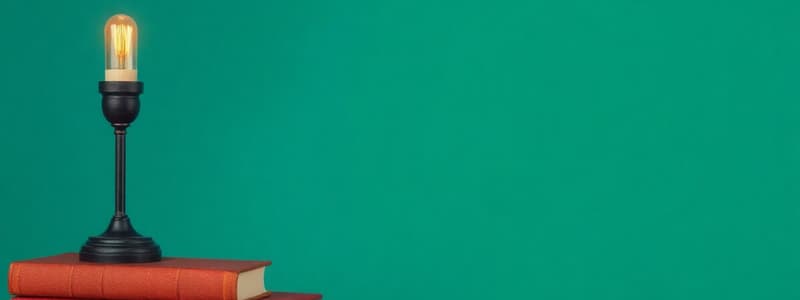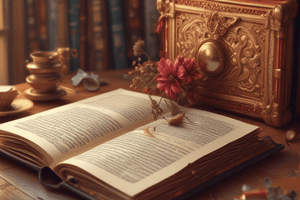Podcast
Questions and Answers
Which element is LEAST likely to be a primary focus when using formalism in literary analysis?
Which element is LEAST likely to be a primary focus when using formalism in literary analysis?
- Author's biography (correct)
- Imagery
- Symbolism
- Meter and rhythm
Which of the following BEST describes the focus of structuralism in literary analysis?
Which of the following BEST describes the focus of structuralism in literary analysis?
- Interpreting the text based on the reader's emotional response
- Understanding the historical context in which the text was written
- Examining the author's personal experiences reflected in the work
- Analyzing underlying patterns and relationships within a text (correct)
Which question is LEAST relevant to a historical criticism approach?
Which question is LEAST relevant to a historical criticism approach?
- What were the prevailing social norms at the time of writing?
- What significant historical events influenced the text?
- What is the reader's personal connection to the text? (correct)
- What were the author's intentions in writing this text?
Which of the following perspectives is MOST aligned with post-structuralism?
Which of the following perspectives is MOST aligned with post-structuralism?
What is the primary objective of feminist literary theory?
What is the primary objective of feminist literary theory?
Which of the following is the MOST accurate definition of Reader-Response Criticism?
Which of the following is the MOST accurate definition of Reader-Response Criticism?
Which of the following theorists is associated with the concept of 'defamiliarization'?
Which of the following theorists is associated with the concept of 'defamiliarization'?
Which literary theory is heavily influenced by the concepts of class struggle and power dynamics?
Which literary theory is heavily influenced by the concepts of class struggle and power dynamics?
Which of the following best describes the 'autotelic' nature of formalism?
Which of the following best describes the 'autotelic' nature of formalism?
In Reader-Response Criticism, what does 'interpretive communities' refer to?
In Reader-Response Criticism, what does 'interpretive communities' refer to?
Which type of Reader-Response Criticism posits that a reader's psychological makeup influences their interpretation of a text?
Which type of Reader-Response Criticism posits that a reader's psychological makeup influences their interpretation of a text?
Which is a key focus of 'New Historicism' as a branch of historical criticism?
Which is a key focus of 'New Historicism' as a branch of historical criticism?
Which approach emphasizes analyzing the unconscious mind, repressed needs, and inner conflicts to determine human behavior?
Which approach emphasizes analyzing the unconscious mind, repressed needs, and inner conflicts to determine human behavior?
What is the central focus of the thematic approach to literary study?
What is the central focus of the thematic approach to literary study?
In the context of archetypes, motifs, and themes, which of the following is the MOST specific to a single work?
In the context of archetypes, motifs, and themes, which of the following is the MOST specific to a single work?
Which of the following is an example of interdisciplinary approach to teaching literature?
Which of the following is an example of interdisciplinary approach to teaching literature?
Why is Reader-Response Criticism considered subjective?
Why is Reader-Response Criticism considered subjective?
In the Types of Formalism, what does 'Defamiliarization' refer to?
In the Types of Formalism, what does 'Defamiliarization' refer to?
Which type of Inquiry-Based Learning provides step-by-step instructions and resources, allowing students to follow a structured process to investigate a problem and find a solution?
Which type of Inquiry-Based Learning provides step-by-step instructions and resources, allowing students to follow a structured process to investigate a problem and find a solution?
Which question would a psychoanalytic critic be MOST likely to ask when analyzing Shakespeare's Hamlet?
Which question would a psychoanalytic critic be MOST likely to ask when analyzing Shakespeare's Hamlet?
If you were using Marxism to analyze The Hunger Games, what aspect of the book would you likely focus on?
If you were using Marxism to analyze The Hunger Games, what aspect of the book would you likely focus on?
Which of the listed benefits is LEAST associated with the act of reading, according to the text?
Which of the listed benefits is LEAST associated with the act of reading, according to the text?
What is the primary emphasis of affective stylistics in reader-response theory?
What is the primary emphasis of affective stylistics in reader-response theory?
Which statement best reflects the relationship between 'Traditional Historicism' and 'New Historicism'?
Which statement best reflects the relationship between 'Traditional Historicism' and 'New Historicism'?
Which educational philosopher emphasized 'learning by doing'?
Which educational philosopher emphasized 'learning by doing'?
An ecocritical analysis of a poem about a forest would primarily focus on:
An ecocritical analysis of a poem about a forest would primarily focus on:
A literary critic is using a Formalist approach to analyze a poem. Which of the following would be their primary focus?
A literary critic is using a Formalist approach to analyze a poem. Which of the following would be their primary focus?
What is the critical difference between a motif and a theme in literary analysis?
What is the critical difference between a motif and a theme in literary analysis?
Which literary theory, heavily influenced by Ferdinand de Saussure, views cultural phenomena as systems of signs?
Which literary theory, heavily influenced by Ferdinand de Saussure, views cultural phenomena as systems of signs?
In the context of inquiry-based learning (IBL), which of the following figures is associated with sociocultural theory and the Zone of Proximal Development (ZPD)?
In the context of inquiry-based learning (IBL), which of the following figures is associated with sociocultural theory and the Zone of Proximal Development (ZPD)?
What is the MOST likely reason for a literary critic to use an interdisciplinary approach?
What is the MOST likely reason for a literary critic to use an interdisciplinary approach?
Which aspect does Marxist Literary Theory prioritize in its analysis of literature?
Which aspect does Marxist Literary Theory prioritize in its analysis of literature?
A reader is applying 'subjective' Reader Response Criticism to a novel. What is the MOST likely outcome of this approach?
A reader is applying 'subjective' Reader Response Criticism to a novel. What is the MOST likely outcome of this approach?
Imagine a formalist critic analyzing a novel. Which element of the novel is LEAST likely to be the central focus of their analysis?
Imagine a formalist critic analyzing a novel. Which element of the novel is LEAST likely to be the central focus of their analysis?
Which of the following literary theories most directly challenges the notion of a single, fixed meaning within a text?
Which of the following literary theories most directly challenges the notion of a single, fixed meaning within a text?
A literary scholar aims to understand how a novel reflects a specific historical event. However, they also want to explore how power dynamics influenced both the event and the novel's interpretation. Which approach is MOST suitable?
A literary scholar aims to understand how a novel reflects a specific historical event. However, they also want to explore how power dynamics influenced both the event and the novel's interpretation. Which approach is MOST suitable?
Which two of the following options are considered to be 'key ideas' of the Reader Response Criticism literary theory?
Which two of the following options are considered to be 'key ideas' of the Reader Response Criticism literary theory?
Flashcards
Literature
Literature
A body of written works, traditionally imaginative poetry and prose of aesthetic excellence.
Archetype
Archetype
Recurring symbol, character, or plot pattern.
Motif
Motif
Recurring element specific to a single work.
Theme
Theme
Signup and view all the flashcards
Literary Theory
Literary Theory
Signup and view all the flashcards
Formalism
Formalism
Signup and view all the flashcards
Structuralism
Structuralism
Signup and view all the flashcards
Post-structuralism
Post-structuralism
Signup and view all the flashcards
Feminism
Feminism
Signup and view all the flashcards
Marxism
Marxism
Signup and view all the flashcards
Psychoanalytic Literary Criticism
Psychoanalytic Literary Criticism
Signup and view all the flashcards
Reader-Response Criticism (RRC)
Reader-Response Criticism (RRC)
Signup and view all the flashcards
Historical Criticism
Historical Criticism
Signup and view all the flashcards
Formalist Criticism
Formalist Criticism
Signup and view all the flashcards
Thematic Approach
Thematic Approach
Signup and view all the flashcards
Ecocriticism
Ecocriticism
Signup and view all the flashcards
Interdisciplinary Approaches
Interdisciplinary Approaches
Signup and view all the flashcards
Inquiry-based Learning
Inquiry-based Learning
Signup and view all the flashcards
Study Notes
- Literature is a body of written works, traditionally imaginative in poetry and prose, valued for their aesthetic qualities.
Defining Literature
- Literature can be classified by language, national origin, historical period, genre, or subject matter.
- Definitions of literature are circular, described as writings with excellence in form, expression, and universal interest.
Key Literary Elements
- Characters are entities in the story.
- Setting is the time and location of the story.
- Narrative accounts of connected events.
- Plot is the sequence of events in a story.
- Conflict is the struggle between opposing forces.
- Theme is the central idea or message.
- Voice is the style or manner of expression.
Archetype vs Motif vs Theme
- Archetype is a universal, recurring symbol, character, or plot pattern.
- Motif is a recurring element specific to a single work.
- Theme is the overarching message or central idea.
Different Genres of Literature
- The different genres are poetry, fiction, non-fiction, drama, and prose.
Theories of Literature
- Literary theory encompasses the ideas and methods to understand literature.
Formalism
- Emphasizes the study of form and style over themes and subject matter.
- Formalists analyze meter, rhyme, rhythm, imagery, symbolism, and other literary techniques.
- Example includes "The Love Song of J. Alfred Prufrock" by T.S. Eliot and "Ulysses" by James Joyce.
Structuralism
- Focuses on analyzing underlying structures in cultural phenomena like language and society.
- It originated from structural linguistics.
- Ferdinand de Saussure, a French linguist developed this approach.
- Structuralism views cultural phenomena as systems of signs, where meaning comes from relationships within the system.
- Analyzes how parts of a story relate to each other, influencing overall meaning.
- Claude Lévi-Strauss analyzed myths and narratives through binary oppositions, like nature vs. culture.
Post-structuralism
- Explores different ways to find meaning in a text by considering the reader's feelings and cultural influences.
- Focuses on the reader's interpretation rather than the writer's intention.
- This focuses more on the opinions of the reader compared to other literary theories.
- Example includes "Jane Eyre" by Charlotte Brontë, focusing on Jane's character vs. Bertha's portrayal.
Feminism
- Feminism is a social, political, and cultural movement advocating for women's rights and gender equality.
- Example includes "A Room of One's Own" by Virginia Woolf.
Marxism
- Examines literature through social and economic structures, particularly class struggle and power dynamics.
- Influenced by Karl Marx.
- Example includes "The Hunger Games" trilogy by Suzanne Collins, depicting a poor vs. elite society.
Psychoanalytic Literary Criticism
- Treats the work as a manifestation of the author's unconscious desires.
- Explains character motivations, analyzes the composition's impact on the unconscious mind, and interprets linguistic/symbolic choices.
- It values the text, author's mind, and reader's interpretation of literary dynamics.
- Example involves analyzing works like "Hamlet" by William Shakespeare (Oedipus complex).
The Importance of Reading
- Cognitive benefits include improved memory, concentration, vocabulary, and critical thinking.
- Emotional benefits encompasses stress reduction and empathy development.
- Social benefits improve social problem-solving, cultural awareness, and communicative skills.
Reader-Response Criticism (RRC)
- Focuses on the experiences of individual readers, emphasizing emotional connection to the context.
- The meaning of a context relies on the response of the readers.
- Emphasizes that meaning is uncertain, depends on the reader's interpretation and reaction.
- Two basic principles: the role of the reader cannot be omitted.
- Readers do not passively consume meaning but instead actively create it.
- RRC is subjective because it focuses on the reader's interpretation rather than objective analysis.
Key Ideas of RRC:
- The Reader is one of the key ideas.
- The Implied Reader is the reader the author had in mind.
- Interpretive Communities is a way to group readers that share a way of interpreting texts.
- The Text is one of the key ideas.
Types of RRC:
- Transactional (Louise Rosenblatt) suggests meaning is actively constructed by the reader's experiences, emotions, and the text.
- Subjective (David Bleich) emphasizes individual interpretation, with no single correct interpretation.
- Psychological (Norman Holland) suggests that a reader's psychological makeup influences their interpretation.
- Affective stylistics (Stanley Fish) examines how a text's structure affects a reader's emotional and cognitive response.
- Social (Stanley Fish) emphasizes the influence of social and cultural context on interpretations.
Historical Criticism
- Examines texts in their historical and cultural contexts to understand the influence of time period, societal norms, and political forces.
- Helps appreciate the author's intentions, themes, and impact on the original audience.
- Objectives include understanding the original historical context and reconstructing the historical situation of the author and audience.
- Key analysis questions include who wrote it, when, significant events, text evolution, and meaning to the first audience.
Authorial Intent
- Original meaning or purpose the author intended at the time of creation.
Two Key Branches of Historical Criticism:
- Traditional Historicism: treats literature as a mirror of historical events, focusing on the author's intent and historical context.
- New Historicism examines how power, ideology, and cultural context shape literature and its interpretation, moving beyond the author's biography.
- Analyzing sources involves checking the authenticity and credibility of both external and internal resources.
Formalist Criticism
- Prioritizes form over thematic concerns or external factors.
- Focuses on form, technique, and literary devices over author's intent or cultural context.
- The main idea of formalism is that it is autotelic, meaning it is self-justifying.
- Proposed by Ferdinand de Saussure.
Types of Formalism:
- Russian Formalism attempts to oppose abstract literary theories. Its main focus is on Victor Shklovsky's defamiliarization.
- Russian Formalism attempts to create a structured basis for the literature study.
- New Criticism focuses on analyzing the text, emphasizing close reading and foregrounding.
- New Critics believed that meaning could be found within the text.
Thematic Approaches
- Focuses on identifying, exploring, and interpreting themes within a text, conveying messages about life, society, and nature.
- Organizes literature by universal themes rather than author or period, connecting it to personal experiences and the world.
- Key components include theme identification, exploration of characters and plot, and symbolism and motifs.
Connection of TA to Different LT:
- Ecocriticism studies literature in the context of human and environmental relationships.
- Psychoanalysis emphasizes on the unconscious mind and repressed thoughts.
- Feminism examines how gender, particularly women, their situation, power, and expectations are portrayed.
Interdisciplinary Approaches
- Connects literary texts with other subjects/disciplines for a comprehensive and engaging experience.
- Promotes connections between literature and other areas of knowledge, fostering understanding and critical thinking.
- History includes "The Diary of a Young Girl" exploring an authentic account of the Holocaust.
- Art includes "Hamlet" and John Everett Millais' painting Ophelia visually reinforces the play
- Music includes "Romeo and Juliet" and Tchaikovsky's musical adaptation translating the play's emotions into music.
- Social Studies includes "To Kill a Mockingbird" examining themes of racial injustice, class disparities, and moral integrity.
Inquiry-based Learning
- Student-centered approach where learning is driven by curiosity and questioning.
- Students explore, investigate, and construct their own understanding through open-ended questions, problems, or scenarios.
4 types of IBL:
- Structured Inquiry Approach provides step-by-step instructions and resources for students.
- Open-Ended Inquiry Approach provides significant autonomy in choosing topics, questions, and methods.
- Problem Based-Inquiry Approach has students solve a real-world problem.
- Guided Inquiry Approach teachers lead the class in the process of inquiry, assisting them by resolving real life issues.
Key figures in IBL:
- John Dewey focuses on learning by doing.
- Jean Piaget focuses on active learning.
- Lev Vygotsky focuses on sociocultural theory.
- Seymour Papert focuses on effective learning when students actively produce products.
- Maria Montessori emphasizes self-directed learning and development of child.
Using Technology in the Classroom
- Technology makes information instantly accessible and enhances educational experiences.
- Technology opens doors for individualized instruction.
- Examples include online libraries, literary databases, interactive platforms, and digital publishing.
Studying That Suits You
Use AI to generate personalized quizzes and flashcards to suit your learning preferences.




